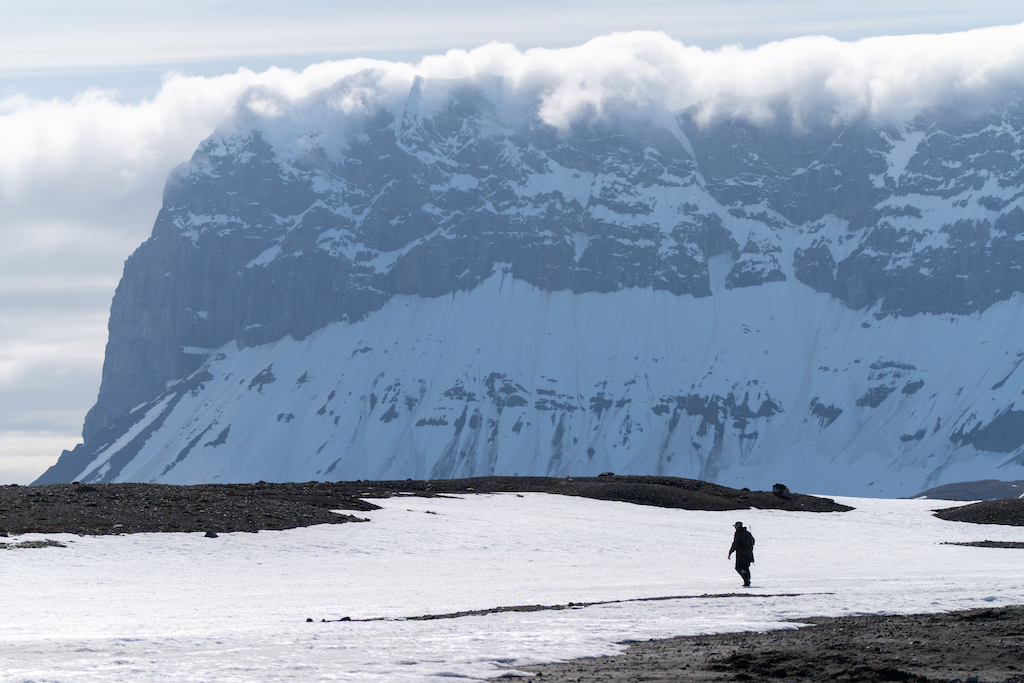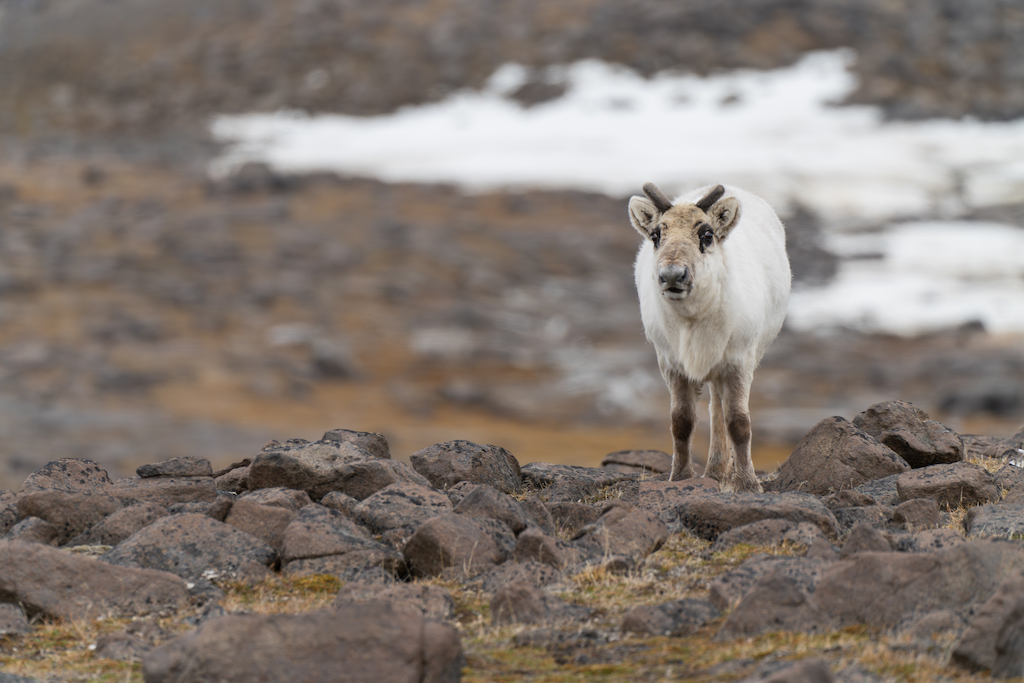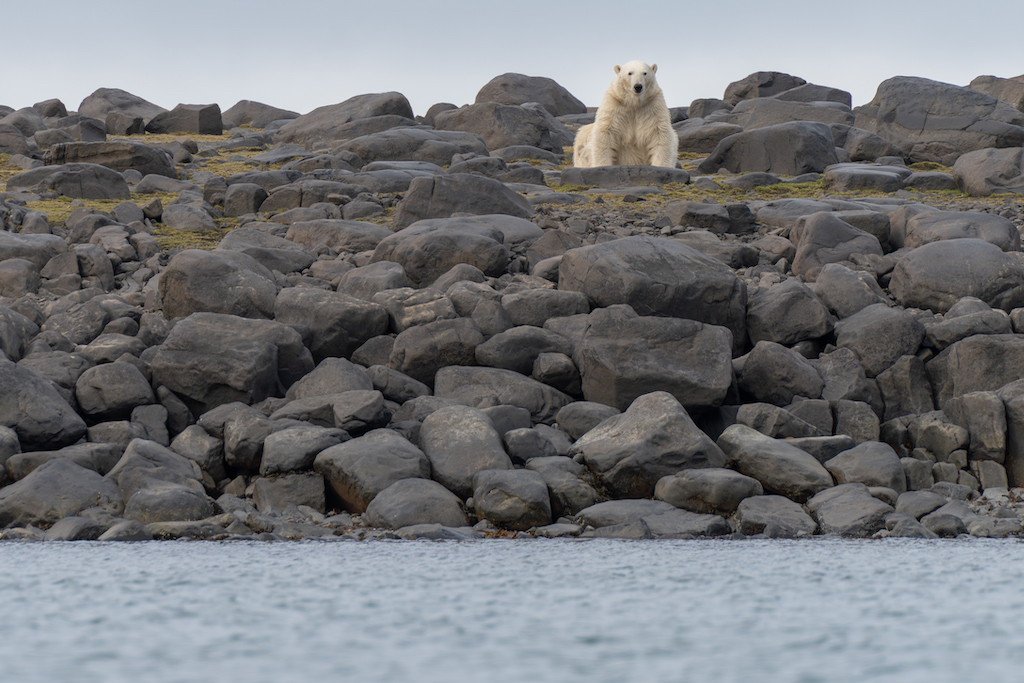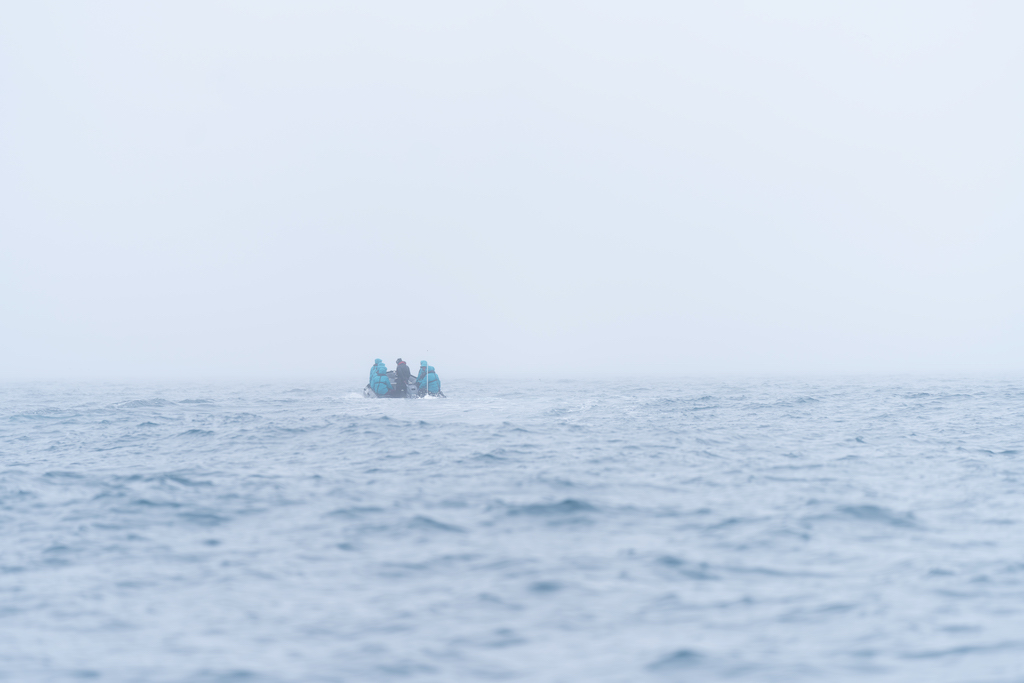This article was written by Maxwell Roche and originally published in Wired For Adventure Volume 20.
Creeping carefully, I skirt the pebbled beach to a perfect photo spot. Jutting out above me are the serrated extremities of an ice shelf. “I wouldn’t advise you to go that way,” says Rune, our seven-foot, bearded Danish guide whom we call ‘The Viking’. “You can take the Zodiac around if you need a photo,” he says signalling for the boat to pick us up. I look down at my reflection in the eerie black water, hallowed by the cliffs, and decide to take his advice. Five minutes later, after a less than successful photoshoot, we motor back around the cliff in the dingy. As I take a deep breath and smile across the boat at my girlfriend Laura the stillness of the morning is interrupted. The house-sized cliff I’d been advised not to walk under accelerates into the sea. As the resulting tidal wave rushes over the front of the boat, so does an emotional wave of equal parts gratitude and disquiet. Amid visions of my own death, being crushed and drowned simultaneously, the realities of polar exploration come crashing down around me. “You saved my life today man” I say to Rune, clapping him on the shoulder as we cruise back to the ship. Scratching a raised eyebrow, he nervously laughs.

As North as You Can Get
So how did I come to be within a hair’s breadth of sudden death a little over 600 miles from the North Pole? Ever since childhood I’d been fascinated by a certain creature. An animal that weighs as much as ten men with four-inch claws and a bite force of 1200 psi (1⁄2 a tonne); an animal that can run 25 miles an hour and can smell a breathing hole in the ice from a kilometre away. I’m talking, of course, about the largest and most powerful carnivore to walk the earth, the polar bear. I had to witness them, and one of the only places to do that was the northernmost inhabited place on earth, so off we went.
The Norwegian sovereign islands of Svalbard are nothing if not unique. They are, thanks to a curious treaty back in 1925, an entirely visa-free zone, meaning everyone and anyone can live there. What you can’t do in Svalbard is die or give birth. If either of those seem imminent you will be promptly transported back to the Norwegian mainland. Crucially though, the islands are unique because they are home to more polar bears than people. Around 2700 people live around the capital Longyearbyen but over 3000 bears inhabit the Barents Sea region. Where better then to track down those illusive and infamous creatures?
Despite its loose immigration policy Svalbard isn’t really a place you can just turn up clutching a Lonely Planet guide and travel wherever the wind blows. Given the extreme nature of the place it is wise, borderline essential, to enlist the services of professional guides or indigenous peoples. The best way to see the islands, and find the bears, we’d been told, was by boat, and so we set about researching a suitable vessel and crew.
“Bonsoir ladies and gentlemen this is Jonathan your expedition leader speaking. The ship has left the harbour and we are under- way.” Jonathon’s thick French accent rattled over the tannoy of our ship of choice; Swan Hellenic‘s SH Diana. He explains in our briefing how we plan to circumnavigate the archipelago in eight days, a journey of 850 nautical miles, ice permitting, and each day make a variety of excursions in Zodiac boats. “The key to Arctic travel” he says, is “Flexibility, flexibility, flexibility. We will go where we can, when we can”. He then goes on to explain some small matters of safety and ends by scrolling through stunning images of the local wildlife, ending poignantly with a picture of a female polar bear and her cubs. “How likely are we to see a bear?” asks a Swiss lady from the front row. “I’m afraid madame” replies Jonathan, “nothing is guaranteed”.
Among Giants
Bing bong. “Gooood morning ladies and gentlemen. It’s now 3am. If you look out on the port side of the ship you will see not only the largest ice shelf in the world but also the largest animal… the blue whale”. Bing bong goes the torturous tannoy. “We know ladies and gentlemen that you’re probably tempted to stay cosy in your beds, but we would like to remind you that an opportunity to see a majestic creature such as this will likely not come around again in your lifetime. See you on deck”. Laura and I open one eye each, let out a tired sigh and donned the prerequisite five lay- ers of thermals before trotting onto the deck.
“There she blows!” calls Johnathan as the whale’s spout blasts visibly on the horizon. The next spout is so close we feel the mist spatter our faces. “Ok” he says as the ship slips audibly into reverse “Now we let her come to us”. Some minutes pass without a sighting. Many of us who’ve made it out onto the deck in anticipation now contemplate returning to our cosy cabins, convinced that the whale, alarmed by our presence, has vanished into the deep. Leaning over the rail we stare into the black depths. A tiny spot of pure brilliant blue swells smoothly upward, turning grey, getting closer, until the wide head and graceful tapered body of the 30 meter, 200 tonne whale explodes onto the surface, scarred and barnacled, within touching distance of the ship’s hull. The noise that erupts from her sofa-sized blowhole is so loud, and so deep, that it shakes my very bones.

The Thrill of the Chase
Bing bong. “Gooood morning ladies and gentlemen, this is your 20-minute call” the velveteen tones of our spectacled French leader wake us gently. It’s 6am and we’ve arrived at Kvalvage, a new anchorage where we will be embarking on our first Zodiac cruise.
Beyond the bow of the Zodiac the day is as still as a day can be. Downy clouds and an electric sky are reflected in the ocean’s mirrored surface. Icebergs formed by ancient glaciers are scattered all around, some the size of coffee tables and some the size of buses, in high-energy brilliant blues.
We are a team of 15 strong and our order of business for the day is to mountaineer high up into the Arctic hills. Our excursion is being led by Rune, a stout Nordic man of around 40-years; an ex-wilderness and wildlife cameraman, with a gun over his shoulder and a lot of expeditions under his belt. Needless to say, we are in good hands. “Wel- come to Nordaustlandet Island” says Rune with a grin “Population zero”.
After thirty minutes of uphill hiking Rune’s radio crackles and the bear spotters up ahead report the discovery of some very large fresh footprints. “There’s a bear nearby,” says Rune sliding the gun off his shoulder and into the crook of his arm. “We need to return to the Zodiac.” I laugh inwardly to myself realising how deeply terrified we all are of encountering a bear, the very thing we have come to the Arctic to see. In fact, throughout the course of the expedition the guides do everything in their power to prevent such an encounter (on land).
Before we start to move again Laura and I take a moment to gaze over our shoulders at the vista. Except for the SH Diana anchored way out in the bay and our trail of footprints cascading toward the shore, not a single trace of human existence is visible. This singularity is perhaps the most powerful experience Svalbard has to offer; the opportunity for a person to stand and look out upon a landscape totally untouched by their own species. It also offers very little in the way of smell, which is a singular experience in itself. There’s only an underlying cold which causes my nostril hairs to crackle.
When we reach the Zodiacs a thick mist has descended and the crew have a new sense of urgency about them. Rune helps Laura into the boat; “Low visibility like this is perfect for the bears, they hunt by smell and could be on top of us any second”. I’m the last guest to climb aboard and as I do so a dark shadow passes through the mist. Rune is still wading in the shallows attempting to free the boat from the rocky beach as the sound of footsteps crunching in the snow and heavy breathing is heard, getting louder. He jumps semi-desperately onto the inflatable perimeter. A large four-legged shape is approach- ing. As the antlers and forlorn face of a reindeer appear Rune lets out an audible “Phew” and we motor back to the ship, perversely disap pointed that we weren’t being hunted.

Hold Your Breath
It’s suddenly the last day of our expedition and, as we travel back to the ship following the final Zodiac cruise, I had to sigh. Our driver, Yan, shrugs his shoulders and gives me a knowing, tight-lipped smile but, just as he does so, the radio crackles. “They’ve spotted a bear,” he announces. There are eight of us on the boat and everyone, including Yan, has stopped breathing. “He’s in the water! He’s in the water!” sounds an anxious voice on the radio. Worried eyes immediately stop scanning the coast and turn to the dark waves. I’m half expecting a giant paw to land on my shoulder and drag me overboard. Suddenly, a deep rumbling sound from amid the rocks. And there he is. A male polar bear stretching and shaking the water from his fur. Yan kills the motor and we float in silence. Regulation dictates that we can’t approach closer than 150m but even from a long way off the sheer weight and power of the creature is obvious. As he wanders back and forth yawning, seemingly unaware or unfazed by our presence, I raise my telescopic camera lens for a better look. Almost comically, as I do, the huge beast catches sight of us over his shoulder and turns, squaring himself, and sitting back on his haunches. Through the camera it feels as though he’s looking into my very soul. Black emotionless eyes, considering the possibility of an easy meal, are juxtaposed by a set of the cutest, fluffiest looking ears. Transfixed, I almost forget to take a picture before he sticks out a long purple tongue, yawns and swaggers off behind the headland to continue his solitary life.

Better Together
If like me you’re an independent sort, with a distinct dislike for supervised, organised travel, and you’ve been worrying throughout this article that it all feels too structured and contrived, then let me just say this. When it comes to a destination as extreme and remote as Svalbard, you really have no choice. You could I suppose smuggle aboard an Norwegian fishing vessel and ask to be dropped off at the first available iceberg, but that just isn’t sensible. Therefore, although it breaks my heart to say it, I would whole-heartedly advise that you travel to the Arctic, on a cruise ship, with an experienced tour operator. Swan Hellenic have been in the cruising business for over 70 years; offering polar punters ice-strengthened adventure cruises in both the Arctic and Antarctic regions since the early 2000’s. Although they don’t have the largest fleet they do have some of the newest and most luxurious vessels with plenty of experienced polar guides and experts to boot. They have the knowledge and expertise not only to get you there, and to keep you safe, but also to educate you in every minute facet of the region. At your disposal will be Glaciologists, Marine Biologists, Ornithologists, in fact nearly every type of Ologist you could imagine; which means, whatever your particular interest, birds, bergs or bears, your questions will never go unanswered. And if your fascination is more towards active exploration, they also have some of the most experienced outdoor adventure guides in the world, who will be eternally psyched to show you around.
The elephant in the room, when it comes to Arctic exploration, is generally monetary; let’s face it, a trip to the polar north is going to set you back quite a lot more than eight days all-inclusive on the Costa Del Sol. Truth-be-told expeditions start at around £8000 for a berth on one of the lower decks (private charter plane transfers from Oslo included). Optional activities for actively adventurous types such as kayaking and hiking here described, are each available for extra fees of around £200. The multiplication of such fees I understand, especially if you wish to have a roomy birth on one of the upper decks, and participate in a number of the extra activities, is likely to be succeeded by a rather large gulp. However, if you’re considering it, then you’ve probably dreamed of going, and if you’ve dreamed of going then it is without question, the investment of a lifetime, because the best things in life aren’t things. Svalbard is one of the planet’s last great wildernesses and ultimately one of the few yet to succumb to human exploitation so… get there before they do! There are only an estimated 26000 polar bears left in the world and although they are adapting to climate change in some incredible ways, numbers are still decreasing due to retreating sea ice and a loss of habitat. The rules on bear observation and viewing distances may also be changing next year, according to our guide Rune; in fact soon the supreme beasts may only be legally witnessed at a minimum distance of 500m, which will require some hella strong binoculars.
Swan Hellenic offer expeditions to Svalbard May to August each year. Visit their website for more details or to book your trip www.swanhellenic.com




